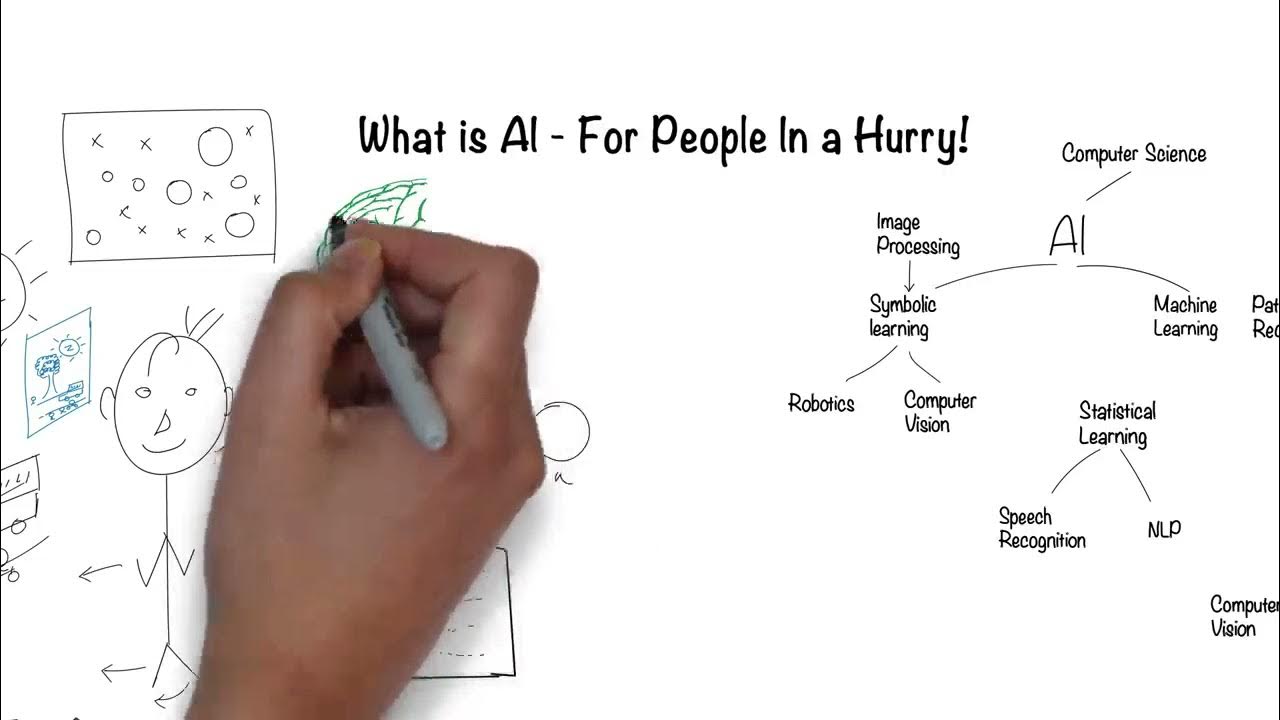What is AI?
Summary
TLDRThis script demystifies artificial intelligence (AI) by comparing it to training a pet, emphasizing its learning process through data analysis. It introduces basic AI for tasks like object recognition and advanced generative AI, which creates content based on internet data. The script warns of potential inaccuracies and ethical issues with AI, urging users to be critical and responsible in their interaction with AI technologies.
Takeaways
- 🧠 AI, or artificial intelligence, is the simulation of human intelligence in computers to perform tasks that usually require human-like thinking.
- 📚 Teaching computers to 'learn' is akin to training a pet, where they are shown many examples to recognize patterns and improve over time.
- 🐕 The analogy of a 'robot dog' is used to explain the basic concept of AI, where it is taught to identify objects like a dog toy through repetition and rewards.
- 🔍 AI improves its performance through continuous learning and feedback, similar to how humans get better at tasks with practice.
- 🎨 Generative AI is a more advanced form of AI that can create original content, such as art, writing, or responses, based on the vast amount of data it has learned from.
- 🌐 Generative AI learns from a wide array of internet sources, including videos, text, and photos, to generate new content.
- ⚠️ There is a risk with generative AI as it can sometimes produce incorrect or harmful content due to its inability to discern right from wrong.
- 🤔 AI does not inherently understand the difference between fact and fiction or the source of its information, which can lead to misinformation.
- 📝 AI might inadvertently plagiarize or use content without proper attribution, as it does not understand the concept of intellectual property.
- 🧐 Humans must critically evaluate the information provided by AI, understanding its strengths and limitations.
- 🛡️ Responsible use of AI is essential, as it requires human oversight to ensure that it is used ethically and effectively.
Q & A
What is the basic definition of AI mentioned in the script?
-AI, or artificial intelligence, is the process of teaching computers to perform tasks that typically require human intelligence, such as recognizing objects, understanding speech, and communicating.
How is teaching AI compared to training a pet in the script?
-Teaching AI is compared to training a pet by using the example of a robot dog learning to fetch a toy, where it starts by recognizing what a 'dog toy' is and gradually improves its performance with rewards for correct answers.
What is the initial challenge faced by the 'robot dog' in the script?
-The initial challenge faced by the 'robot dog' is not knowing what a 'dog toy' is, which is the first concept it needs to learn.
How does the 'robot dog' improve its recognition over time?
-The 'robot dog' improves its recognition by being shown lots of pictures of 'dog toys', making mistakes initially but learning from each correct answer that acts as a reward.
What is the difference between basic AI and generative AI as described in the script?
-Basic AI learns by analyzing lots of data, while generative AI is more complex and creative, capable of improvisation in tasks like making art or writing.
What kind of content does generative AI learn from according to the script?
-Generative AI learns from a wide range of content available on the internet, including videos, text, photos, and more.
Why might the output of a generative AI be considered a 'catch' as per the script?
-The output of a generative AI can be a 'catch' because it may sometimes make mistakes, not differentiate between good and bad, and may not always distinguish facts from fiction or know the source of its information.
What are some potential issues with the information created by generative AI?
-Potential issues include the creation of unhelpful or harmful content, inability to credit sources properly, and the indiscriminate use of random or non-random information from the internet.
According to the script, what responsibility do humans have when using AI?
-Humans have the responsibility to think critically about the information received from AI, understand its strengths and limitations, and use it smartly and responsibly.
What does the script suggest about the relationship between AI and human oversight?
-The script suggests that while AI can perform tasks and even create content, human oversight is crucial to ensure the responsible and accurate use of AI technology.
Outlines

This section is available to paid users only. Please upgrade to access this part.
Upgrade NowMindmap

This section is available to paid users only. Please upgrade to access this part.
Upgrade NowKeywords

This section is available to paid users only. Please upgrade to access this part.
Upgrade NowHighlights

This section is available to paid users only. Please upgrade to access this part.
Upgrade NowTranscripts

This section is available to paid users only. Please upgrade to access this part.
Upgrade Now5.0 / 5 (0 votes)





